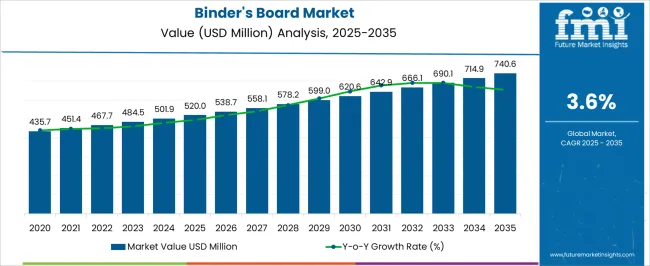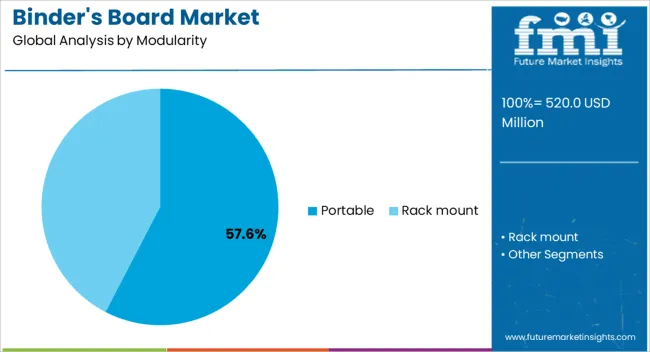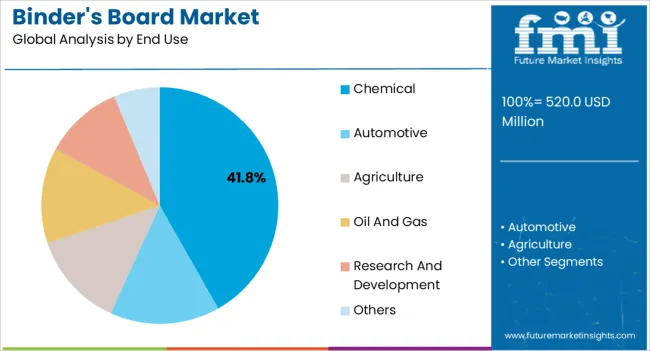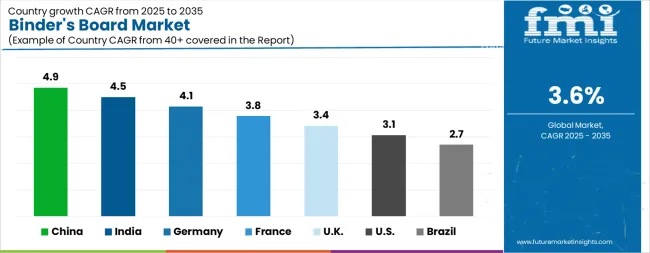The Binder's Board Market is estimated to be valued at USD 520.0 million in 2025 and is projected to reach USD 740.6 million by 2035, registering a compound annual growth rate (CAGR) of 3.6% over the forecast period.

| Metric | Value |
|---|---|
| Binder's Board Market Estimated Value in (2025 E) | USD 520.0 million |
| Binder's Board Market Forecast Value in (2035 F) | USD 740.6 million |
| Forecast CAGR (2025 to 2035) | 3.6% |
The Binder’s Board market is being driven by increasing demand for lightweight, modular, and durable packaging solutions across various industries. The current market landscape reflects a growing preference for boards that are easily transported, assembled, and customized to meet different packaging and structural needs. Rising investments in sustainable materials and eco-friendly solutions are also supporting the market’s growth, as end users seek alternatives that reduce environmental impact while maintaining performance.
The market outlook remains positive, with expected expansion in sectors such as chemicals, consumer goods, and industrial applications. Factors such as improvements in adhesive technologies, moisture resistance, and cost-effective manufacturing processes are further enhancing product appeal.
The shift toward portable and modular designs is enabling industries to respond quickly to changing requirements while reducing logistics and storage costs As businesses aim for more flexible supply chains and adaptive packaging solutions, the Binder’s Board market is expected to benefit from innovation and increased adoption, particularly in regions where industrial and chemical sectors are rapidly expanding.
The binder's board market is segmented by modularity, end use, and geographic regions. By modularity, binder's board market is divided into Portable and Rack mount. In terms of end use, binder's board market is classified into Chemical, Automotive, Agriculture, Oil And Gas, Research And Development, and Others. Regionally, the binder's board industry is classified into North America, Latin America, Western Europe, Eastern Europe, Balkan & Baltic Countries, Russia & Belarus, Central Asia, East Asia, South Asia & Pacific, and the Middle East & Africa.

The portable modularity segment is projected to hold 57.60% of the Binder’s Board market revenue share in 2025, making it the leading segment within the modularity classification. The segment’s dominance is being attributed to the increasing need for packaging and structural solutions that can be easily transported and assembled without specialized equipment. Portability has become a key feature as industries aim to reduce handling times and transportation costs while improving supply chain efficiency.
The segment’s growth has been supported by rising demand from sectors requiring temporary installations, quick-response packaging, and modular storage solutions. The ability to configure boards into different shapes and sizes without permanent fixtures has allowed manufacturers and users to adapt to fluctuating requirements.
In addition, the portability feature supports industries focused on sustainability, as reusable and lightweight boards reduce waste and resource consumption As automation and logistics optimization continue to gain importance, the portable modularity segment is expected to remain a primary growth driver in the Binder’s Board market.

The chemical end use segment is expected to account for 41.80% of the Binder’s Board market revenue share in 2025, establishing it as the largest segment within the end-use classification. The segment’s leadership is being driven by the growing requirement for safe, durable, and corrosion-resistant packaging and containment solutions within the chemical industry. As regulations surrounding the storage and transport of hazardous and sensitive materials tighten, demand for protective packaging has increased significantly.
Binder’s boards are being favored for their ability to offer structural integrity while being lightweight and moisture-resistant, which are critical features in chemical handling. The segment’s growth has also been supported by increased production capacities in chemical manufacturing hubs and heightened investments in logistics infrastructure.
Additionally, the adaptability of boards to accommodate different chemical products without compromising safety standards has further expanded their application With industry stakeholders focusing on reducing environmental impact and improving supply chain resilience, the chemical end use segment is expected to continue driving the Binder’s Board market’s growth trajectory.
A binder’s board is a type of smooth, hard, and tough paperboard product which is extensively used in the form of covers by bookbinders to protect books and writing papers. It is also known as book board, cover board, cylinder board, spec board, and El-Hi board. These boards are customizable and available in a variety of thicknesses, shapes, and sizes. The demand for binder’s board has witnessed constant growth due to the moderate consumption growth in the book and publishing industry. With the introduction of digital publication of books, magazines, and novels, the binder’s board market may decline during the forecast period. Also, consumers in the developed as well as in developing countries are moving towards digitalization, which in turn will contribute to the sluggish demand for binder’s boards in the near future. Some of the important factors that define properties of binder’s boards are – caliper, pH level, surface design, trimming, and curl. According to PAPTAC G-25 (Pulp and Paper Technical Association of Canada), the pH level for a binder’s board should lie between 6 and 8. The surface must be even and free from indentations, lumps, and mechanical imperfections. All the edges of a binder’s board must be trimmed smooth. A binder’s board could be produced from both virgin and recycled fibers.

| Country | CAGR |
|---|---|
| China | 4.9% |
| India | 4.5% |
| Germany | 4.1% |
| France | 3.8% |
| UK | 3.4% |
| USA | 3.1% |
| Brazil | 2.7% |
The Binder's Board Market is expected to register a CAGR of 3.6% during the forecast period, exhibiting varied country level momentum. China leads with the highest CAGR of 4.9%, followed by India at 4.5%. Developed markets such as Germany, France, and the UK continue to expand steadily, while the USA is likely to grow at consistent rates.
Brazil posts the lowest CAGR at 2.7%, yet still underscores a broadly positive trajectory for the global Binder's Board Market. In 2024, Germany held a dominant revenue in the Western Europe market and is expected to grow with a CAGR of 4.1%.
The USA Binder's Board Market is estimated to be valued at USD 193.6 million in 2025 and is anticipated to reach a valuation of USD 261.8 million by 2035. Sales are projected to rise at a CAGR of 3.1% over the forecast period between 2025 and 2035. While Japan and South Korea markets are estimated to be valued at USD 28.3 million and USD 17.7 million respectively in 2025.
| Item | Value |
|---|---|
| Quantitative Units | USD 520.0 Million |
| Modularity | Portable and Rack mount |
| End Use | Chemical, Automotive, Agriculture, Oil And Gas, Research And Development, and Others |
| Regions Covered | North America, Europe, Asia-Pacific, Latin America, Middle East & Africa |
| Country Covered | United States, Canada, Germany, France, United Kingdom, China, Japan, India, Brazil, South Africa |
| Key Companies Profiled | Smurfit Kappa Group, Eska BV, Nippon Paper Industries Co., Ltd., Mondi Group, International Paper Company, Mayr-Melnhof Karton AG, WestRock Company, and GPC Paper and Packaging |
The global binder's board market is estimated to be valued at USD 520.0 million in 2025.
The market size for the binder's board market is projected to reach USD 740.6 million by 2035.
The binder's board market is expected to grow at a 3.6% CAGR between 2025 and 2035.
The key product types in binder's board market are portable and rack mount.
In terms of end use, chemical segment to command 41.8% share in the binder's board market in 2025.






Our Research Products

The "Full Research Suite" delivers actionable market intel, deep dives on markets or technologies, so clients act faster, cut risk, and unlock growth.

The Leaderboard benchmarks and ranks top vendors, classifying them as Established Leaders, Leading Challengers, or Disruptors & Challengers.

Locates where complements amplify value and substitutes erode it, forecasting net impact by horizon

We deliver granular, decision-grade intel: market sizing, 5-year forecasts, pricing, adoption, usage, revenue, and operational KPIs—plus competitor tracking, regulation, and value chains—across 60 countries broadly.

Spot the shifts before they hit your P&L. We track inflection points, adoption curves, pricing moves, and ecosystem plays to show where demand is heading, why it is changing, and what to do next across high-growth markets and disruptive tech

Real-time reads of user behavior. We track shifting priorities, perceptions of today’s and next-gen services, and provider experience, then pace how fast tech moves from trial to adoption, blending buyer, consumer, and channel inputs with social signals (#WhySwitch, #UX).

Partner with our analyst team to build a custom report designed around your business priorities. From analysing market trends to assessing competitors or crafting bespoke datasets, we tailor insights to your needs.
Supplier Intelligence
Discovery & Profiling
Capacity & Footprint
Performance & Risk
Compliance & Governance
Commercial Readiness
Who Supplies Whom
Scorecards & Shortlists
Playbooks & Docs
Category Intelligence
Definition & Scope
Demand & Use Cases
Cost Drivers
Market Structure
Supply Chain Map
Trade & Policy
Operating Norms
Deliverables
Buyer Intelligence
Account Basics
Spend & Scope
Procurement Model
Vendor Requirements
Terms & Policies
Entry Strategy
Pain Points & Triggers
Outputs
Pricing Analysis
Benchmarks
Trends
Should-Cost
Indexation
Landed Cost
Commercial Terms
Deliverables
Brand Analysis
Positioning & Value Prop
Share & Presence
Customer Evidence
Go-to-Market
Digital & Reputation
Compliance & Trust
KPIs & Gaps
Outputs
Full Research Suite comprises of:
Market outlook & trends analysis
Interviews & case studies
Strategic recommendations
Vendor profiles & capabilities analysis
5-year forecasts
8 regions and 60+ country-level data splits
Market segment data splits
12 months of continuous data updates
DELIVERED AS:
PDF EXCEL ONLINE
Binders Market Size and Share Forecast Outlook 2025 to 2035
Board Games Market Size and Share Forecast Outlook 2025 to 2035
Onboard Marine Gensets Market Size and Share Forecast Outlook 2025 to 2035
Boxboard Packaging Market Analysis - Size, Share, and Forecast Outlook 2025 to 2035
On-Board Connectivity Market Size and Share Forecast Outlook 2025 to 2035
On-board Magnetic Sensors Market Trends and Forecast 2025 to 2035
Market Share Insights of Boxboard Packaging Providers
On-Board Fuse Box Market
Chipboard Box Market Size and Share Forecast Outlook 2025 to 2035
Cardboard Flask Market Size, Share & Forecast 2025 to 2035
Cardboard Crates Market Size and Share Forecast Outlook 2025 to 2035
Cardboard Trays Market Size, Share & Forecast 2025 to 2035
Industry Share & Competitive Positioning in Chipboard Box Industry
Market Share Breakdown of Cardboard Crates Manufacturers
Dashboard Camera Market Growth - Trends & Forecast 2024 to 2034
Cardboard Filler Market Trends – Size, Demand & Forecast 2024-2034
Cardboard Tubs Market
Greyboard Market
Paperboard Partition Market Size and Share Forecast Outlook 2025 to 2035
Paperboard Packaging Market Size and Share Forecast Outlook 2025 to 2035

Thank you!
You will receive an email from our Business Development Manager. Please be sure to check your SPAM/JUNK folder too.
Chat With
MaRIA